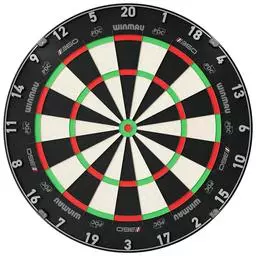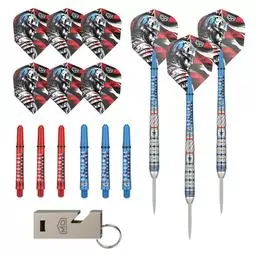![]()
1. OBJECT OF THE GAME. 14.1 is a nomination game. The player must nominate a ball and a pocket. The player is awarded one point for every correctly nominated and pocketed ball on a legal stroke, and is allowed to continue his turn until he either fails to pocket a nominated ball or commits a foul. The player can pocket the first 14 balls, but before he can continue his turn by shooting at the 15th (and last remaining) ball on the table, the 14 pocketed balls are racked as before, except with the apex space vacant. The player then attempts to pocket the 15th ball in a manner so that the racked balls are disturbed and he can continue his run.
The player who scores the pre-determined point total for a game (usually 150 in major tournament play or any agreed upon total in casual play) prior to his opponent, wins the game.
2. PLAYERS. 2, or 2 teams.
3. BALLS USED. Standard set of object balls numbered 1-15, plus cue ball.
4. THE RACK. Standard triangle rack with the apex ball on the foot spot, 1-ball on the racker's right corner, 5-ball on left corner. Other balls are placed at random and must touch their neighbors.
5. SCORING. Any ball legally pocketed counts one point for the shooter.
6. OPENING BREAK. Starting player must either (1) designate a ball and a pocket into which that ball will be pocketed and accomplish the shot, or (2) cause the cue ball to contact a ball and then a cushion, plus cause two object balls to contact a cushion. Failure to meet at least one of the above requirements is a breaking violation. Offender's score is assessed a two point penalty for each breaking violation. In addition, the opponent has the choice of (1) accepting the table in position, or (2) having the balls reracked and requiring the offending player to repeat the opening break. That choice continues until the opening break is not a breaking violation, or until the opponent accepts the table in position. The three successive fouls rule does not apply to breaking violations.
If the starting player scratches on a legal opening break, he is charged with a foul and assessed a one point penalty, which applies toward the "Successive Fouls Penalties." The incoming player is awarded cue ball in hand behind the head string, with object balls in position.
7. RULES OF PLAY.
- A legally pocketed ball entitles a shooter to continue at the table until he fails to legally pocket a called ball on a shot. A player may shoot any ball he chooses, but before he shoots, must designate the called ball and called pocket. He need not indicate any detail such as kisses, caroms, combinations, or cushions (all of which are legal). any additionally pocketed ball(s) on a legal stroke is scored as one point for the shooter.
- On all shots, a player must cause the cue ball to contact an object ball and then (1) pocket a numbered ball, or (2) cause the cue ball or any numbered ball to contact a cushion. Failure to meet these requirements is a foul.
When an object ball is not frozen to a cushion, but is within a ball's width of a cushion (referee to determine by measurement if necessary), a player is permitted only two consecutive legal safeties on that ball using only the near rail. If such safety play is employed, that object ball is then considered frozen to the rail on the player's next inning. The General Rules of Pocket Billiards "Frozen Balls" requirements apply if the player chooses to make his first cue ball contact with that object ball on his third shot.
(Note: If a player has committed a foul on the shot immediately before or the shot immediately after playing this ball, then he must immediately meet the requirements of the "Frozen Ball" rule when playing this object ball. Also, if he has committed two consecutive fouls, he must immediately meet the requirements of the "Frozen Ball" rule when playing this object ball. If such player fails to meet the requirements of the "Frozen Ball" rule, he is considered to have committed a third successive foul and the appropriate point penalty is assessed as well as one point for each of the previous fouls. All fifteen balls are then reracked and the player committing the infraction is required to break as at the beginning of the game.) - When the fourteenth ball of a rack is pocketed, play stops momentarily with the fifteenth ball remaining in position on the table; the fourteen pocketed balls are then racked (with the space at the foot spot vacant in the triangle). Player then continues, normally pocketing the fifteenth (or "break" ball) in such manner as to have the cue ball carom into the rack and spread the balls to facilitate the continuance of his run. However, player is not compelled to shoot the fifteenth ball; he may shoot any ball he desires.
- A player may call a safety rather than an object ball (for defensive purposes). Safety play is legal, but must comply with all applicable rules. Player's inning ends when a safety is played, and pocketed balls are not scored. Any object ball pocketed on a called safety is spotted.
- A player may not catch, touch, or in any way interfere with a ball as it travels toward a pocket or the rack area on a shot (to include catching a ball as it enters a pocket by having a hand in the pocket). If he does, he is charged with a special "deliberate foul" and is penalized one point for the foul and an additional fifteen point penalty, for a total of sixteen points. The incoming player then has choice of (1) accepting the table in position with the cue ball in hand behind the head string, or (2) having all fifteen balls reracked and requiring the offending player to shoot under the requirements of the opening break.
- If the fifteenth (unpocketed) ball of a rack and/or the cue ball interferes with the triangle being lowered straight down into position for racking, refer to the diagram, which indicates the proper manner of relocating balls. (The lined out boxes are those situations in which there is no interference, both balls remain in position.)
- When a player has the cue ball in hand behind the head string (as after a scratch) and all object balls are behind the head string, the object ball nearest the head string may be spotted at his request. If two or more balls are an equal distance from the head string, the player may designate which of the equidistant balls he desires to have spotted.


